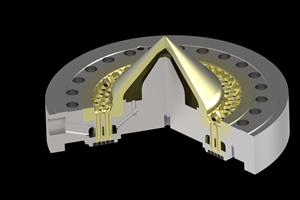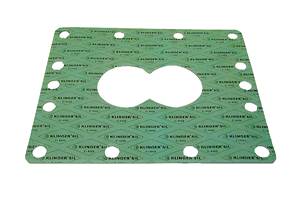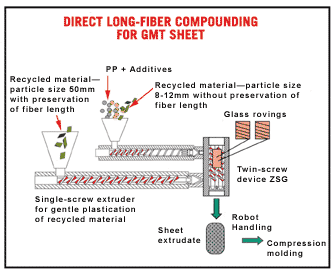Long-Glass PP Makes InroadsIn Automotive Front Ends
Injection molded, long-glass-reinforced polypropylene appears to be the staple of new automotive front-end systems (FES) designed with a high degree of parts integration.
Injection molded, long-glass-reinforced polypropylene appears to be the staple of new automotive front-end systems (FES) designed with a high degree of parts integration. This material has not previously been used in front-end carriers, but some auto makers—particularly in Europe—view it as a strong candidate for replacing compression molded PP glass-mat thermoplastic (GMT) sheet, as well as hybrid systems made by overmolding engineering plastics onto metal.
Among the most recent developments is a front-end carrier for BMW’s 2002 Mini-Platform vehicles. It is injection molded of 30% long-glass PP from Stamax LLC, the joint venture of Owens Corning and DSM in the Netherlands. The PP carrier reduces cost by integrating “hang-on” front-end components such as the radiator, horn, condenser, and brackets into one part. It also reduces part weight by around 30% versus GMT.
Meanwhile, Dow Automotive is proposing a plastic/steel hybrid system based on long-glass/PP joined to steel not by overmolding but with Dow’s developmentalnstructural adhesive system. Called LESA (for low-energy surface adhesive), it is a two-part, acrylic-epoxy adhesive that bonds PP to metal without flame or corona treatment or a primer. Dow has made a prototype LESA-bonded FES for Volkswagen AG.
Driving out cost
Robert Eller, a consultant based in Akron, Ohio, expects integrated front ends using long-glass/PP to catch on earliest in Europe where “open-architecture” assembly methods are widely used. This method uses longitudinal rails to meet front-end impact and energy-absorption requirements, making it easier for front-end carriers to be bolted in place. The “closed architecture” approach favored in the U.S. is less amenable to replacing metal front-end carriers.
In the longer-term, Eller expects the significant economic and performance advantages of emerging technologies for in-line compounding and molding of long-glass/PP to play an increasing role in integrated front-end carriers.
In the mid-1990s, Volkswagen in Germany pioneered long-glass/PP FES by adopting compression molded GMT parts joined by heat staking or riveting. More recently, Bayer AG (German parent of Bayer Corp.) has gained ground in FES with a patented hybrid system of glass-filled nylon 6 overmolded onto stamped sheet metal. The latest evolution of Bayer’s hybrid FES concept appears on the 2002 Volkswagen Polo. Using an in-mold assembly method, Bayer’s Durethan BKV 130 H2.0 glass-reinforced nylon 6 overmolds and bonds together three pieces of sheet steel. For the first time, this hybrid front end involves molding both the visible surface (with grained texture) and the structural support. Hot-runner molding eliminates the previous need to remove sprues from the structural component after demolding.
Breaking new ground with its all-plastic, injection molded FES, BMW has adopted Stamax P30YM240, a 30% long-glass, pelletized PP compound for its Mini-Platform cars being built and assembled in the U.K. The 120,000-unit/yr BMW program includes the Mini-Cooper S vehicle to be marketed in the U.S. “Integrated design of BMW’s 6.6-lb front-end carrier using our glass-reinforced PP results in major weight reduction and consolidation of what would have been around 20 steel parts into a single carrier,” says Maria Ciliberti, commercial leader at Stamax North America, U.S. subsidiary of Stamax LLC. The BMW front-end carrier is molded on 1500-ton presses by the U.K. division of Faurecia, the French injection molding group.
Industry sources say the special design needs of the BMW platform imposed constraints on the extent of parts integration achieved. One source familiar with the project, who asked for anonymity, commented that BMW’s carrier falls short of being a fully structural FES in several respects. For instance, the headlights are not integrated into the carrier because road vibrations could damage sensitive lighting components. And the latch-locking requirements are met using side-mounted support systems that attach to the longitudinal metal rails. Finally, the BMW thermoplastic carrier was not intended to meet full front-impact requirements alone. Metal cross-beams are still used.
Stamax compounds (available here from Stamax North America) are made with patented technology that coats the long glass fiber with a low-molecular-weight PP, ensuring full wet-out and excellent dispersion. The long-glass PP compound is supplied in the form of 0.5-in.-long pellets.
To further improve the cost-effectiveness of these compounds, Stamax LLC recently came out with a 60% long-glass PP concentrate. This form can be let down at the press with virgin PP to provide just the amount of reinforcement needed for a specific application. A 75% long-glass Stamax concentrate will be introduced shortly.
Novel structural adhesive
Several years ago, Dow set out to determine “the best available solutions to creating a fully-structural FES,” says Padraig Naughton, a global technology leader for exterior systems at Dow Automotive. The company concluded that long-glass PP is clearly the best choice due to its lower cost and density relative to other materials. Dow then settled on combining steel and PP composite using its LESA adhesive system. This material reportedly can bond dissimilar materials without primer or pretreatment—including plastic to metal and PP to nylon, SMC, or SRIM.
Dow acquired the basic LESA chemistry from a European university. It is a two-part system that cures at room temperature in the presence of oxygen from the air. “Open time” after mixing can be varied from 2 to 15 min. Bonded assemblies set up sufficiently to withstand handling after a few minutes, though full cure takes 24 hr.
Although Dow Automotive is developing its own long-glass PP compounds, Naughton notes the LESA approach is not tied to any particular method of incorporating long glass in PP. Dow’s robotically applied adhesive is said to increase structural integrity and stiffness of the front-end carriers. Naughton credits this to its chemical bonding of the plastic to metal. In contrast, injection overmolding creates a rivet-like, mechanical bond by forcing nylon through holes or openings stamped into metal inserts.
The LESA method creates a “continuous joint” between plastic and metal, adds Naughton. He says this reduces stress concentrations (weak points) and makes it possible to design “closed box” sections into the FES. Both effects are said to result in increased part stiffness and better structural performance.
Using the LESA approach, Dow Automotive has prototyped an FES comparable to a metal/plastic hybrid system currently used on the Volkswagen Golf. Dow is confident that its concept will be adopted for commercial use in the next few years. Beyond front-end carriers, Dow envisions using the LESA adhesive system to bond integrated air-intake manifolds, doors, tailgates, and fender modules. (The first commercial use is expected to be a glass-filled nylon air-intake manifold for a 2004 European car.)
Related Content
What to Know About Your Materials When Choosing a Feeder
Feeder performance is crucial to operating extrusion and compounding lines. And consistent, reliable feeding depends in large part on selecting a feeder compatible with the materials and additives you intend to process. Follow these tips to analyze your feeder requirements.
Read MoreHow to Maintain Pelletizing Quality When Acid Attacks
Developments in the chemistry of polymers and additives have made corrosion a real problem in pelletizers. Here’s how to ward it off.
Read MoreGreen’s the Theme in Extrusion/Compounding
The drive toward circular economy is requiring processors to make more use of PCR. Machine builders at K—across all extrusion processes—will be highlighting innovations to help them do just that.
Read More10 Ways to Improve Twin-Screw Compounding Performance
There are many techniques known to operators and plant engineers for increasing the performance of a twin-screw compounding extruder.
Read MoreRead Next
Now Molders Make Their Own GMT Sheet
The latest sign of an upsurge of interest in direct long-fiber compounding by molders of reinforced thermoplastics is a technology that allows molders to produce their own glass-mat thermoplastic (GMT) composite sheet.
Read MoreWhy Long-Glass Molders Are Compounding In-Line
Compounding raw fiberglass directly into thermoplastic molded parts is growing rapidly in Europe, and now it’s coming here. D-LFT, as it’s called, promises to make large parts cheaper and stronger—but with new technological risks and higher up-front investment costs.
Read MorePeople 4.0 – How to Get Buy-In from Your Staff for Industry 4.0 Systems
Implementing a production monitoring system as the foundation of a ‘smart factory’ is about integrating people with new technology as much as it is about integrating machines and computers. Here are tips from a company that has gone through the process.
Read More
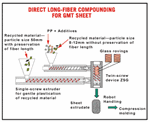



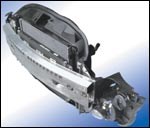
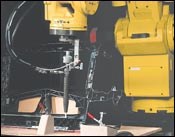




.png;maxWidth=300;quality=90)















